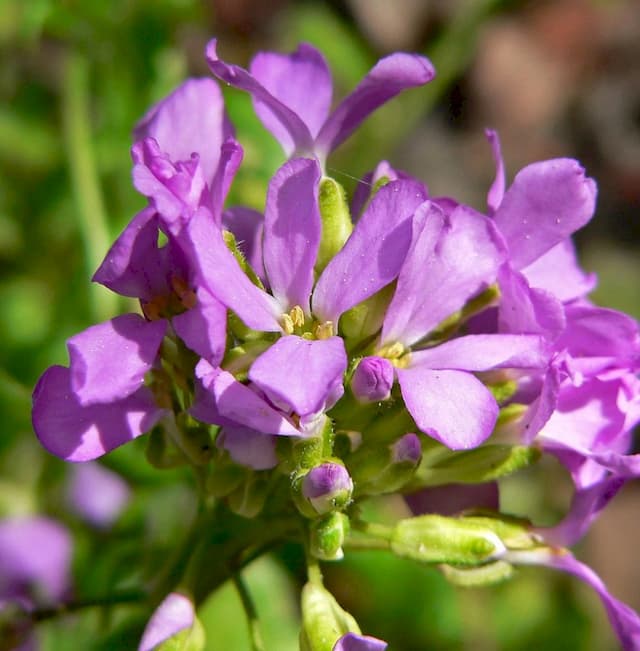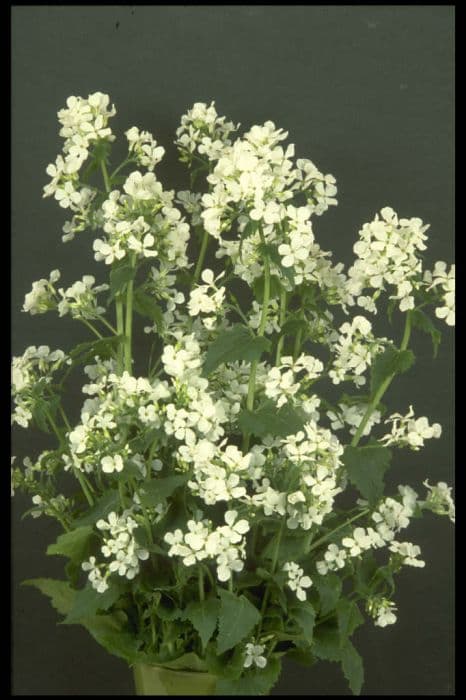Sweet Alyssum Lobularia maritima Golf Series

ABOUT
The Lobularia maritima Golf Series, commonly known as sweet alyssum, is a charming and picturesque plant renowned for its lush, vibrant appearance. This delightful variety boasts dense clusters of small flowers that often come in shades of white, pink, purple, or lavender. These blossoms are typically arranged in a honeycomb-like pattern, each with delicate, rounded petals that contribute to the plant's frothy, soft aesthetic. The foliage of sweet alyssum is equally attractive, composed of narrow, lance-shaped leaves that are slightly hairy and have a grayish-green hue. These leaves form a neat, compact mound that serves as a perfect backdrop for the profuse blooms. The contrast between the green of the leaves and the pastel colors of the flowers creates a harmonious and captivating display. The Golf Series of sweet alyssum is particularly noted for its vigorous growth and exceptional flowering capabilities. These characteristics make it an excellent choice for gardeners aiming to add a long-lasting splash of color to their landscapes. Despite its delicate appearance, the plant is surprisingly resilient and can even tolerate mild coastal conditions, making it a versatile addition to a variety of garden settings.
About this plant
 Names
NamesFamily
Brassicaceae
Synonyms
Sweet Alyssum, Sweet Alison, Seaside Lobularia
Common names
Alyssum maritimum, Alyssum minus, Alyssum maritimus, Koniga maritima, Lobularia maritima
 Toxicity
ToxicityTo humans
Sweet alyssum is generally considered non-toxic to humans. It does not contain any known toxic compounds that would pose a threat when touched or ingested in typical amounts. As with any plant material, individual allergies or sensitivities could cause mild irritation or an adverse reaction, but this is not common. Consequently, eating or handling sweet alyssum is not usually associated with significant health risks.
To pets
Sweet alyssum is also considered non-toxic to pets. It is not known to contain any substances that are harmful to dogs, cats, or other domestic animals. Pets that ingest sweet alyssum may experience mild gastrointestinal upset if they consume large quantities, but this plant is typically safe around pets without any significant risk of poisoning.
 Characteristics
CharacteristicsLife cycle
Annuals
Foliage type
Evergreen
Color of leaves
Green
Flower color
Varies
Height
4-6 inches (10-15 cm)
Spread
6-12 inches (15-30 cm)
Plant type
Herb
Hardiness zones
9
Native area
Mediterranean
Benefits
 General Benefits
General Benefits- Ornamental Appeal: Adds aesthetic value to gardens with its delicate flowers and pleasant fragrance.
- Low Maintenance: Requires minimal care, making it suitable for novice gardeners or those with limited time.
- Drought Tolerance: Once established, it can tolerate periods of dry conditions, reducing the need for frequent watering.
- Fast Growing: Quick to germinate and grow, providing swift ground coverage and bloom.
- Attracts Pollinators: Flowers attract butterflies and bees, supporting local ecosystems.
- Compact Growth: The Golf Series is known for its compact habit, which is ideal for border edges, containers, and small gardens.
- Long Blooming Season: Offers a prolonged display of flowers from spring to fall.
 Medical Properties
Medical PropertiesThis plant is not used for medical purposes.
 Air-purifying Qualities
Air-purifying QualitiesThis plant is not specifically known for air purifying qualities.
 Other Uses
Other Uses- Lobularia maritima, commonly known as sweet alyssum, can be used as a ground cover to prevent soil erosion due to its dense and low-growing nature.
- Sweet alyssum is sometimes utilized in companion planting to attract beneficial insects such as predatory wasps, which help to control pest populations in the garden.
- The plant is often included in green roof plantings due to its hardiness, low growth habit, and drought resistance, contributing to urban biodiversity.
- Sweet alyssum can be used in sensory gardens for its soft texture and fragrant flowers that provide a tactile and olfactory experience.
- In floral art, the small, delicate flowers of sweet alyssum are used as filler material in bouquets and arrangements to provide a contrast in scale and texture.
- It is also employed as a natural border along walkways and paths to create a defined edge with a pop of color and fragrance.
- The plant serves as a living mulch, its dense growth helping to keep the soil moist and cool, reducing the need for frequent watering.
- As part of a xeriscaped garden, which requires little to no irrigation, sweet alyssum is ideal for its drought tolerance once established.
- The sweet scent of alyssum flowers has been used in perfumery, capturing the essence of its fragrance for use in scented products.
- Sweet alyssum can be planted in hanging baskets and window boxes for urban gardening, utilizing vertical space and beautifying balconies and facades.
Interesting Facts
 Feng Shui
Feng ShuiSweet Alyssum is not used in Feng Shui practice.
 Zodiac Sign Compitability
Zodiac Sign CompitabilitySweet Alyssum is not used in astrology practice.
 Plant Symbolism
Plant Symbolism- Innocence: Lobularia maritima, commonly known as Sweet Alyssum, often symbolizes innocence due to its delicate small flowers.
- Beauty: The sweet-scented and aesthetically pleasing blooms represent beauty and are used in gardens to enhance visual appeal.
- Protection: Sweet Alyssum was traditionally planted as a protective charm to ward off negativity and to attract positive energies.
- Discreet Charm: Its ability to thrive in cracks and crevices with minimal soil demonstrates a subtle allure and resilient beauty.
- Calm and Soothing Presence: The Sweet Alyssum's soft fragrance and plush carpet of flowers create a relaxing ambiance, symbolizing tranquility.
 Water
WaterSweet Alyssum should be watered regularly, especially during dry spells, to keep the soil consistently moist but not waterlogged. During warmer months, watering may be needed at least once or twice a week, with a thorough soaking that provides about one gallon of water per square foot every week. In cooler months or when rainfall is sufficient, watering frequency can be reduced. Always check the top inch of soil for dryness before watering and adjust accordingly as Sweet Alyssum is sensitive to overwatering.
 Light
LightSweet Alyssum thrives in full sun to partial shade conditions. Ideally, it should receive at least six hours of sunlight each day. The plant will perform best if placed in a location where it receives morning sunlight and some afternoon shade, especially in hotter climates to prevent scorching.
 Temperature
TemperatureSweet Alyssum prefers moderate temperatures and can generally tolerate conditions between 40°F and 85°F. However, it thrives in temperatures that are consistently around 60°F to 75°F. While it can survive light frosts, extended exposure to temperatures below freezing may damage or kill the plant.
 Pruning
PruningPruning Sweet Alyssum encourages bushier growth and more blooms. Trim back the plant by one-third after the first flowering period to promote a second bloom. Pruning is best done in late spring or early summer but can be done any time the plant appears leggy or overgrown.
 Cleaning
CleaningAs needed
 Soil
SoilSweet Alyssum thrives in light, well-draining soil with a moderate nutrient level, ideally a mix of peat, compost, and perlite or vermiculite. The preferred soil pH for Sweet Alyssum is slightly acidic to neutral, ranging from 6.0 to 7.0.
 Repotting
RepottingSweet Alyssum, being an annual, typically does not require repotting. Instead, it is replanted each season. However, if grown as a perennial in warmer climates, it can be repotted every couple of years or as needed.
 Humidity & Misting
Humidity & MistingSweet Alyssum is tolerant of a range of humidity levels but prefers moderate conditions. It does not require high humidity and is quite adaptable to the average outdoor ambient humidity.
 Suitable locations
Suitable locationsIndoor
Ensure plenty of light, avoid overwatering Sweet Alyssum.
Outdoor
Plant in full sun to part shade with good air circulation.
Hardiness zone
7-11 USDA
 Life cycle
Life cycleLobularia maritima, commonly known as Sweet Alyssum, begins its life cycle as a seed which, when sown in warm soil, will typically germinate in 7-14 days. After germination, the seedling stage is characterized by the growth of the first true leaves, which enable the plant to start photosynthesis. The vegetative stage follows, marked by rapid foliage growth, as the plant develops multiple branches and reaches full leaf coverage. The flowering stage is next, with the Sweet Alyssum producing small, fragrant flowers in clusters; this stage can continue throughout the growing season if temperatures remain conducive. During the reproductive stage, the flowers are pollinated, leading to the formation of seed pods; once mature, these pods release seeds for the next generation. Finally, as an annual plant, after setting seed, the Sweet Alyssum completes its life cycle, typically dying with the first hard frost.
 Propogation
PropogationPropogation time
Spring to Summer
Propogation: The plant commonly known as sweet alyssum, Lobularia maritima Golf Series, is most commonly propagated by seeds. The ideal time for sowing these seeds is in early spring after the threat of frost has passed for direct outdoor sowing or earlier if starting them indoors under controlled conditions. To propagate sweet alyssum by seed, simply sprinkle the tiny seeds onto the surface of the soil where you wish them to grow or in a seed-starting mix if starting indoors. The seeds need light to germinate, so they should only be lightly pressed into the soil rather than covered. Maintaining the soil's moisture without overwatering is crucial, and in temperatures between 55 to 65 degrees Fahrenheit (13 to 18 degrees Celsius), germination should occur within 7 to 14 days. Once the seedlings have grown and the danger of frost has passed, they can be transplanted to their final growing location outdoors.


![Aubrieta [Axcent Lilac]](/_next/image?url=https%3A%2F%2Fplants-admin.emdemapps.com%2Fimages%2Fplants%2F%2Fimages%2F604b5e2430fac.png&w=640&q=75)






